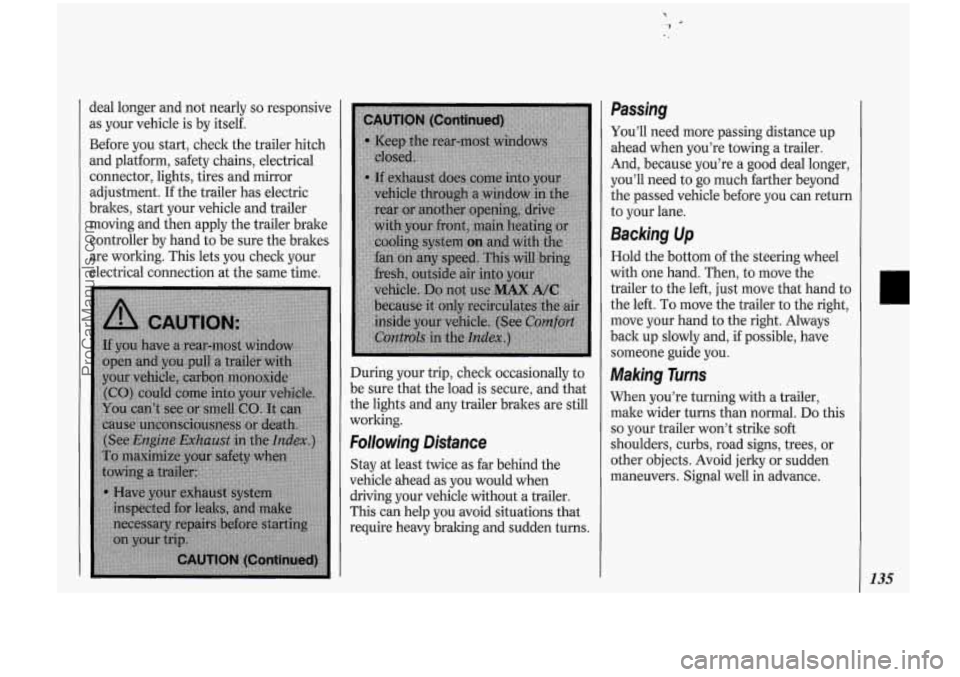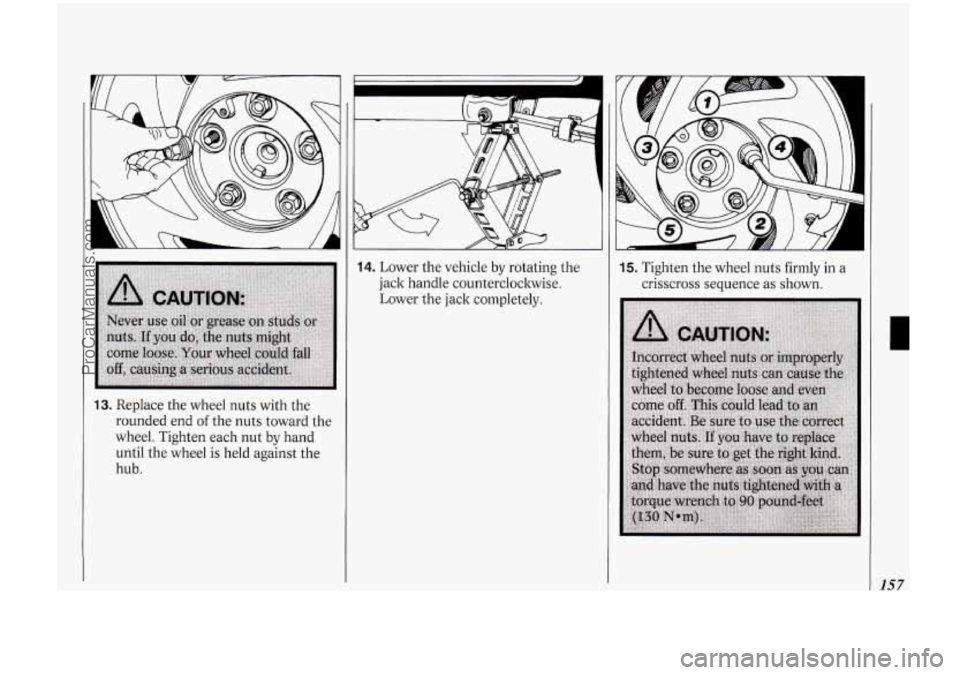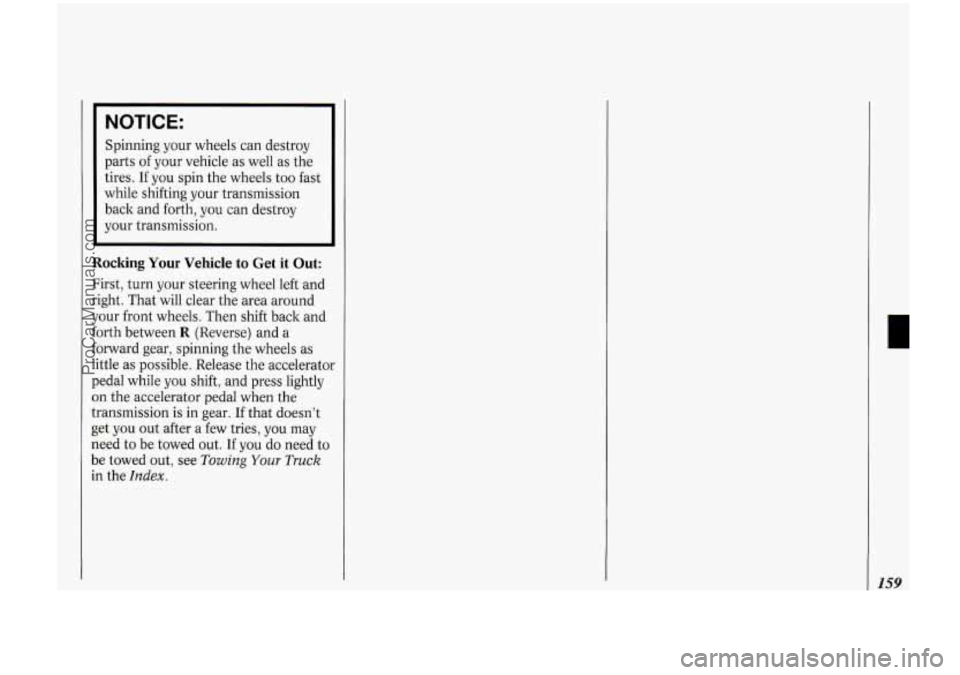tow OLDSMOBILE BRAVADA 1994 Owner's Manual
[x] Cancel search | Manufacturer: OLDSMOBILE, Model Year: 1994, Model line: BRAVADA, Model: OLDSMOBILE BRAVADA 1994Pages: 248, PDF Size: 14.54 MB
Page 141 of 248

deal longer and not nearly so responsive
as your vehicle is by itself.
Before you start, check the trailer hitch
and platform, safety chains, electrical
connector, lights, tires and mirror
adjustment.
If the trailer has electric
brakes, start your vehicle and trailer
moving and then apply the trailer brake
controller by hand to be sure the brakes
are working. This lets you check your
electrical connection at the same time.
During your trip, check occasionally to
be sure that the load is secure, and that
the lights and any trailer brakes are still
working.
following Distance
Stay at least twice as far behind the
vehicle ahead as you would when
driving your vehicle without a trailer.
This can help
you avoid situations that
require heavy braking and sudden turns.
Passing
You’ll need more passing distance up
ahead when you’re towing a trailer.
And, because you’re a good deal longer,
you’ll need to go much farther beyond
the passed vehicle before you can return
to your lane.
Backing Up
Hold the bottom of the steering wheel
with one hand. Then, to move the
trailer to the left, just move that hand to
the left. To move the trailer to the right,
move your hand to the right. Always
back up slowly and, if possible, have
someone guide you.
Making Turns
When you’re turning with a trailer,
make wider turns than normal. Do this
so your trailer won’t strilte soft
shoulders, curbs, road signs, trees, or
other objects. Avoid jerky or sudden
maneuvers. Signal well in advance.
LI
ProCarManuals.com
Page 142 of 248

Your Driving and the Road
Turn Signals When Towing a
Trailer
When you tow a trailer, your vehicle has
to have a different turn signal flasher
and extra wiring. The green arrows on
your instrument panel will flash
whenever you signal a turn or lane
change. Properly hooked up, the trailer
lights will also flash, telling other
drivers you’re about to turn, change
lanes or stop.
When towing a trailer, the green arrows
on your instrument panel will flash for
turns even if the bulbs on the trailer are
burned out. Thus, you may think
drivers behind you are seeing your
signal when they are not, It’s important
to check occasionally to be sure the
trailer bulbs are still working.
Driving On Grades
Reduce speed and shift to a lower gear
before you start down a long or steep
downgrade. If you don’t shift
down, you
might have to use your brakes
so much
that they would get hot and no longer
work well. On
a long uphill grade, shift down and
reduce your speed
to around 45 mph
(70 km/h) to reduce the possibility of
engine and transmission overheating.
If you are towing a trailer that weighs
more than
3,000 pounds (1 350 kg), it’s
best to drive in
D instead of Overdrive
(or, as you need to, a lower gear). This
will minimize heat build-up and extend
the life of your transmission.
Parking on Hills
You really should not park your vehicle,
with a trailer attached, on a hill.
If
something goes wrong, your rig could
start to move. People can be injured,
and both your vehicle and the trailer
can be damaged.
But if you ever have to park your rig on
a hill, here’s how to do it:
1. Apply your regular brakes, but don’t
shift into
P (Park) yet.
2. Have someone place chocks under
the trailer wheels.
3. When the wheel chocks are in place,
release the regular brakes until the
chocks absorb the load.
4. Reapply the regular brakes. Then
apply your parking brake and then
shift to
P (Park).
5. Release the regular brakes.
When You Are Ready to Leave
After Parking on
a Hill
1. Apply your regular brakes and hold
the pedal down while you:
Start your engine;
Shift into a gear; and
Release the parking brake.
2. Let up on the brake pedal.
3. Drive slowly until the trailer is clear
4. Stop and have someone pick up and
of
the chocks.
store the chocks.
Maintenance When Trailer Towing
Your vehicle will need service more
often when you’re pulling a trailer. See
the Maintenance Schedule for more on
this. Things that are especially
important in trailer operation are
automatic transmission fluid (don’t
overfill), engine oil, axle lubricant, belt,
cooling system, and brake adjustment.
Each of these is covered in this manual,
ProCarManuals.com
Page 145 of 248

Here you’ll find what to do about some
problems that can occur on the road
.
Part 5
Problems on the Road
Hazard Warning Flashers ........................................................................\
............... 140
Jump Starting ........................................................................\
.................................. 140
Towing Your Bravada ........................................................................\
..................... 144
Engine Overheating ........................................................................\
......................... 145
If a Tire Goes Flat ........................................................................\
........................... 151
Changing a Flat Tire ........................................................................\
........................ 151
If You’re Stuck: In Sand, Mud, Ice or Snow ......................................................... 158
0
139
ProCarManuals.com
Page 150 of 248

Problems on the Road
144
Towing Your Bravada
Try to have a GM dealer or a
professional towing service tow your
vehicle. The usual towing equipment is:
(A) Sling-type tow truck
(B) Wheel-lift tow truck
(C) Car carrier
If your vehicle has been changed or
modified since it was factory-new by
adding aftermarket items like aero
skirting or special tires and wheels,
these instructions may not be correct.
Before you do anything, turn on the
hazard warning flashers.
NOTICE:
Dollies must be used on ground
wheels or vehicle damage will occur.
When you call, tell the towing service:
That your vehicle has all-wheel drive
and cannot be towed with any wheels
in contact with the ground. Your
vehicle requires dollies with sling-type
or wheel-lift equipment, or a car
carrier.
The make, model, and year of your
vehicle.
Whether you can still move the shift
lever.
If there was an accident, what was
damaged.
When the towing service arrives, let the
tow operator how that this manual
contains towing instructions. The
operator may want to see them.
ProCarManuals.com
Page 151 of 248

When your vehicle is being towed, have
the ignition key off. The steering wheel
should be clamped in a straight-ahead
position, with a clamping device
designed for towing service.
Do not use
the vehicle’s steering column lock for
this. The transmission should be in
P (Park) and the parking brake
released.
Don’t have your Bravada towed with
the wheels in contact with the ground.
If your vehicle is being towed with
sling-type or wheel-lift equipment,
either the front or rear wheels must be
supported on a dolly.
If towing your Bravada with a car
carrier, block supports may be required
to prevent damage to the vehicle.
Engine Overheating
You will find a coolant temperature
;age and the warning light about
a hot
mgine on your Oldsmobile’s instrument
)anel.
If Steam Is Coming From Your
Engine
!45
ProCarManuals.com
Page 152 of 248

Problems on the Road
146
NOTICE:
If your engine catches fire because
you keep driving with no coolant,
your vehicle can be badly damaged.
The costly repairs would not be
covered by your warranty.
If No Steam Is Coming From Your
Engine
If you get the overheat warning but see
or hear no steam, the problem may not
be too serious. Sometimes the engine
can get a little too hot when you:
Climb a long hill on a hot day.
Stop after high speed driving.
Idle for long periods in traffic.
Tow a trailer.
If you get the overheat warning with no
sign of steam, try this for a minute or
so:
1. Turn off your air conditioner.
2. Turn on your heater to full hot at the
highest fan speed and open the
window as necessary.
3. If you’re in a traffic jam, shift to
N (Neutral). If
you no longer have the overheat
warning, you can drive. Just to be safe,
drive slower for about ten minutes.
If
the warning doesn’t come back on, you
can drive normally.
If the warning continues, pull over,
stop, and park your vehicle right away.
If there’s still no sign of steam, push the
accelerator until the engine speed is
about twice as fast as normal idle speed.
Bring the engine speed back to normal
idle speed after two or three minutes.
Now see
if the warning stops. But then,
if you still have the warning, TURN
OFF THE ENGINE AND GET
EVERYONE OUT
OF THE VEHICLE
until it cools down.
You may decide not to lift the hood but
to get service help right away.
Cooling System
When you decide it’s safe to lift the
hood, here’s what you’ll see:
(A) Coolant recovery tank
(B) Radiator pressure cap
If the coolant inside the coolant
recovery tank is boiling, don’t do
anything else until it cools down.
ProCarManuals.com
Page 157 of 248

Engine Fan Noise
This vehicle has a clutched engine
cooling fan. When the clutch is engaged,
the fan spins faster to provide more air
to cool the engine. In most everyday
driving conditions the clutch is not
engaged. This improves fuel economy
and reduces fan noise. Under heavy
vehicle loading, trailer towing and/or
high outside temperatures, the fan speed
increases when the clutch engages.
So
you may hear an increase in fan noise.
This is normal and should not be
mistaken as the transmission slipping or
making extra shifts. It is merely the
cooling system functioning properly.
The fan will slow down when additional
cooling is not required and the clutch
disengages. You may also hear this fan
noise when you start the engine. It will
go away
as the fan clutch disengages.
I Ifa Tire Goes Flat
It’s unusual for a tire to “blow out”
while you’re driving, especially if you
maintain your tires properly. If air goes
out of a tire, it’s much more likely to
leak out slowly. But if you should ever
have a “blowout,” here are a few tips
about what to expect and what to do:
If a front tire fails, the flat tire
will
create a drag that pulls the vehicle
toward that side. Take your foot
off the
accelerator pedal and grip the steering
wheel firmly. Steer to maintain lane
position, then gently brake to a stop
well out of the traffic lane.
A rear blowout, particularly on a curve,
acts much like a skid and may require
the same correction you’d use in a skid.
In any rear blowout, remove your foot
from the accelerator pedal. Get the
vehicle under control by steering the
way you want the vehicle to go. It may
be very bumpy and noisy, but you can
still steer. Gently brake to a stop, well
off the road if possible.
If a tire goes
flat, the next section shows
how to use your jacking equipment to
change a flat tire safely.
I Changing a Flat Tire
If a tire goes flat, avoid further tire and
wheel damage by driving slowly to a
level place. Turn
on your hazard
warning flashers.
151
ProCarManuals.com
Page 163 of 248

13. Replace the wheel nuts with the
rounded end
of the nuts toward the
wheel. Tighten each nut by hand
until the wheel is held against the
hub.
14. Lower the vehicle by rotating the
jack handle countercloclnvise.
Lower the jack completely. 15. Tighten the wheel nuts firmly in a
crisscross sequence as shown.
157
ProCarManuals.com
Page 165 of 248

NOTICE:
Spinning your wheels can destroy
parts
of your vehicle as well as the
tires.
If you spin the wheels too fast
while shifting your transmission
back and forth, you can destroy
your transmission.
Rocking Your Vehicle to Get it Out:
First, turn your steering wheel left and
right. That will clear the area around
your front wheels. Then shift back and
forth between
R (Reverse) and a
forward gear, spinning the wheels as
little as possible. Release the accelerator
pedal while you shift, and press lightly
on the accelerator pedal when the
transmission
is in gear. If that doesn’t
get you out after a few tries, you may
need
to be towed out. If you do need to
be towed out, see
Towing Your Truck
in the Index.
159
ProCarManuals.com
Page 169 of 248

Fuel
Use regular unleaded gasoline rated at
87 octane or higher. Use premium
unleaded gasoline rated at 91 octane or
higher for high power performance,
when towing a trailer or with a high
payload requirement. But when
operating with a light load as
a normal
condition, you may use middle grade or
regular unleaded gasolines.
The gasoline you use should meet
specifications ASTM D4814 in the U.S.
and CGSB
3.5-92 in Canada. These
fuels should have the proper additives,
so you should not have to add anything
to the fuel.
In the
U.S. and Canada, it’s easy to be
sure you get the right kind of gasoline
(unleaded). You’ll see “UNLEADED” right
on the pump. And only unleaded
nozzles will fit into your vehicle’s filler
neck.
Be sure the posted octane is at least 91
for premium, 89 for middle grade and
87 for regular.
If the octane is less than
87, you may get a heavy knocking noise
when you drive. If it’s bad enough, it
can damage your engine.
If you’re using fuel rated at 91 octane or
higher and you still hear heavy
knocking, your engine needs service.
But don’t worry
if you hear a little
pinging noise when you’re accelerating
or driving up a hill. That’s normal, and
you don’t have to buy a higher octane
fuel to get rid of it. It’s the heavy,
constant knock that means you have a
problem.
What about gasoline with blending
materials that contain oxygen
(oxygenates), such as MTBE or
alcohol?
MTBE is “methyl tertiary-butyl ether.”
Fuel that
is no more than 15% MTBE is
fine for your vehicle.
Ethanol is ethyl or grain alcohol.
Properly-blended fuel that is no more than
10% ethanol is
fine for your
vehicle.
Methanol is methyl or wood alcohol.
NOTICE:
Fuel that is more than 5%
methanol is bad for your vehicle.
Don’t use it. It can corrode metal
parts in your fuel system and also
damage plastic and rubber parts.
That damage wouldn’t be covered
under your warranty. And even at
5% or less, there must be
“cosolvents” and corrosion
preventers in this fuel to help avoid
these problems.
GasoUnes for Cleaner Air
Your use of gasoline with deposit
control additives will help prevent
deposits from forming in your engine
and fuel system. That helps keep your
engine in tune and your emission
control system working properly. It’s
good for your vehicle, and you’ll be
doing your part for cleaner air.
Many gasolines are now blended with
oxygenates. General Motors
163
ProCarManuals.com